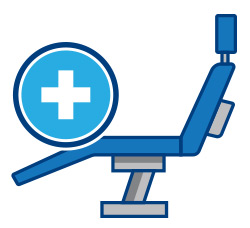Care For Dental Chairs
Dental chair maintenance begins with reading the instructions and cleaning procedures that come with your dental chair. They provide very clear instructions as to the types of cleansers that can be used, how often the chair should be cleaned and procedures for dental chair disinfection.
Barrier Technique
Manufacturers strongly advocate the barrier technique be used whenever possible to preserve the finish and appearance of the equipment. Wherever possible, disposable barriers should be used and changed between patients. The barrier technique will ensure maximum long-term durability of the surfaces and finishes of the equipment. Using barriers to control infection in lieu of dental surface disinfectants will most effectively increase the longevity of all of the surfaces on the chair. If a barrier becomes compromised, or if visible contamination is present on an upholstered surface, a registered hospital grade DIN disinfectant should be used.
Disinfection
Minimize the use of surface disinfectants on the upholstery. Chemicals can cause deterioration and shorten the life of upholstered surfaces. Disinfectants may cause damage and NO disinfectant should be considered HARMLESS to dental equipment.

 Unacceptable Disinfectants
Unacceptable Disinfectants
These disinfectants will harm the surface finishes of dental equipment and are not recommended.
Chemical Composition
- ethyl alcohol or isopropyl alcohol (greater than 25% by volume)
- hydrogen peroxide
- chlorine compounds (such as sodium hypochlorite)
- strong phenols/phenol-alcohol combinations
- sodium bromide
- household cleaners (Dental Equipment Only)
- citric acid
- iodophors / iodine compounds
- ammonium hydroxide (“ammonia”)
 Conditionally Acceptable Disinfectants
Conditionally Acceptable Disinfectants
These disinfectants have been found to be the least harmful to the equipment surfaces.
Chemical Composition
- quaternary ammonium compounds (“quats”)
- high-dilution water-based phenolic compounds
- quaternary ammonium compounds (“quats”, plus less than 25% alcohol by volume)
The degree of damage is influenced by several factors including, but not limited to: the chemical(s) used, level of exposure, and length of time. Buildups of disinfectant are known to harm and/or discolor the upholstery’s protective coating as well as the chair’s other surfaces.

Dental chair is in good condition

Over time, without proper maintentance and care, the dental chair accumulates a buildup of disinfectant, leading to discolouring of the upholstery.


Dental chair is showing signs of discolouring

With proper maintenance and care, including following maxill’s recommended cleaning steps, the upholstery can be restored to good condition.


Dental chair is back to good condition
Cleaning
If you must use disinfectants, then clean the chair afterwards as described below. Regardless of the chemical disinfectant used, it is imperative that the equipment be thoroughly washed at least once per day. This washdown will minimize the harmful effects of chemical disinfectant residues that have been allowed to accumulate on the equipment. When using chemical disinfectants, always pay strict attention to the disinfectant manufacturer’s directions.
NOTE: As with all cleaning products, first clean a small inconspicuous area to ensure the material will not discolour or fade.
NOTE: The longer a stain is allowed to set, the more difficult it will be to remove.
NOTE: Use damp, not wet, cleaning cloths around control switches and other openings. Do not allow liquid to run into the interior of the chair.
It is recommended that each stain be cleaned in a step by step manner using the sequence below:
For Daily Cleaning:
- maxill offers SCHIFF’S CHAIR CLEANER & POLISH for convienient everyday chair cleaning. Its formulation is gentle and safe for use on leather and vinyl upholsteries. SCHIFF’S CHAIR CLEANER & POLISH does not contain mineral oil, is low in VOCs and its non-flammable formula helps to prevent static build-up.
- Alternatively, use a solution of 10% household liquid non-ionic dish soap mixed with warm water and apply with a soft damp cloth to remove most soiling and buildups. If necessary, rinse, re-dampen the cloth and continue working out remaining residue. Then wipe the surface clean with a soft clean water-dampened cloth.
- Do not use “Citrus”, “Bleach” or other variations of these cleaners. Use only the original formulas.
For more difficult stains not solved by above methods:
- Mild abrasion may be required to remove stains. In an inconspicuous spot, try using micro-fibre cloths with water and super mild abrasive (E.g. ENJO with MARBLE PASTE) or a Magic Eraser. Bristle brushes or scouring pads will damage the upholstery.
- Dampen a soft white cloth with a standard 70% formulation of Isopropyl (rubbing) alcohol and rub an inconspicuous area of the material first, ensure that no discolouration has occurred, and then rub the stained area gently 6 times. Note: Use extreme caution with this method. Complete only in a well-ventilated area and away from any open flame. Rinse with a water-dampened cloth.
- NEVER use Acetone (finger nail polish remover), Sodium Hypochlorite (bleach), Naphtha (lighter fluid) or D-limonene (citrus cleaners). These are known to damage the chair’s finish.


